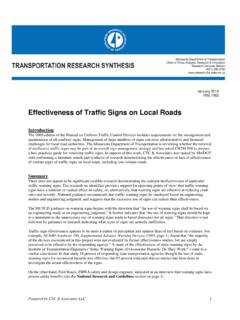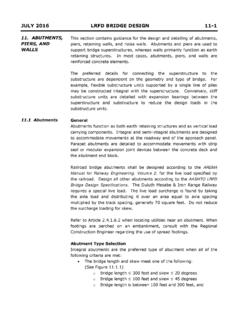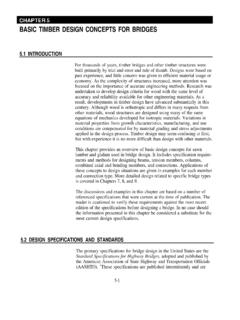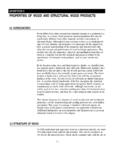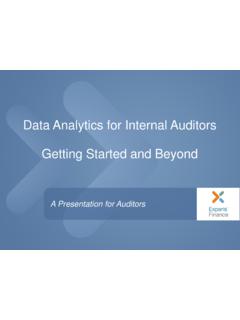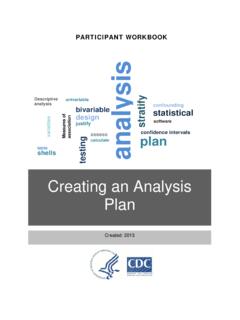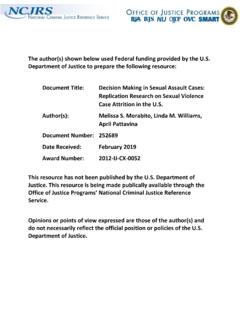Transcription of Major Equipment Life-cycle Cost Analysis
1 Major Equipment Life-cycle cost Analysis Douglas D. Gransberg, Principal InvestigatorInstitute for TransportationIowa State University April 2015 Research ProjectFinal report 2015-16To request this document in an alternative format call 651-366-4718 or 1-800-657-3774 (Greater minnesota ) or email your request to Please request at least one week in advance. Technical report Documentation Page 1. report No. 2. 3. Recipients Accession No. MN/RC 2015-16 4. Title and Subtitle 5. report Date Major Equipment life -c ycle cost Analysis April 2015 6. 7. Author(s) 8. Performing Organization report No. Douglas D. Gransberg and Edward Patrick O Connor 9. Performing Organization Name and Address 10. Project/Task/Work Unit No. Iowa State University Institute for transportation 2711 South Loop Drive, Suite 4700 Ames, Iowa 50010-8664 11. Contract (C) or Grant (G) No. (c) 99004 (wo) 8 12. Sponsoring Organization Name and Address 13. Type of report and Period Covered minnesota department of transportation Research Services & Library 395 John Ireland Boulevard, MS 330 St.
2 Paul, minnesota 55155-1899 final report 14. Sponsoring Agency Code 15. Supplementary Notes 16. Abstract (Limit: 250 words) Equipment Life-cycle cost Analysis (LCCA) is typically used as one component of the Equipment fleet management process and allows the fleet manager to make Equipment repair, replacement, and retention decisions on the basis of a given piece of Equipment s economic life . The objective of this research is to develop a robust method that permits Equipment fleet managers to maximize the cost effectiveness of the fleet by optimizing the overall Life-cycle value of each piece in the fleet. Minneapolis Public Works Fleet Services Division (MPWFSD) Equipment fleet data was utilized in developing the proposed stochastic LCCA model for public agency s fleet. The research compared output using actual data from current software to the output from the new stochastic LCCA method using Equipment deterioration curves and probabilistic input variables for capital costs, fuel, and other operating costs to demonstrate enhanced ability to optimize fleet management decisions.
3 The interest rate was found to have a greater impact on economic life output than fuel prices for a dump truck. The fuel volatility did impact the Life-cycle costs when applying the stochastic confidence levels. Based on Monte Carlo simulation sensitivity Analysis results , the time factor and engine factor were found to be the most sensitive input variables to the LCCA model. This leads to the conclusion that when deciding to replace a piece of Equipment , engine efficiency should be a high priority due to the costs associated with the time factor, engine factor, and its subsequent annual usage. 17. Document Analysis /Descriptors 18. Availability Statement Equipment Life-cycle cost Analysis , Equipment maintenance, Fleet management, Benefit cost Analysis No restrictions. Document available from: National Technical Information Services, Alexandria, Virginia 22312 19. Security Class (this report ) 20. Security Class (this page) 21. No. of Pages 22. Price Unclassified Unclassified 107 Major Equipment Life-cycle cost Analysis final report Prepared by: Douglas D.
4 Gransberg Edward Patrick O Connor Institute for transportation Iowa State University April 2015 Published by: minnesota department of transportation Research Services & Library 395 John Ireland Boulevard, MS 330 St. Paul, MN 55155 This report represents the results of research conducted by the authors and does not necessarily represent the views or policies of the minnesota Local Road Research Board, the minnesota department of transportation , or Iowa State University. This report does not contain a standard or specified technique. The authors, the minnesota Local Road Research Board, the minnesota department of transportation , and Iowa State University do not endorse products or manufacturers. Any trade or manufacturers names that may appear herein do so solely because they are considered essential to this report . ACKNOWLEDGEMENTS The authors of the report would like to acknowledge the support provided for this project by the minnesota Local Roads Research Board, with special thanks to John Scharfbillig and the members of the research oversight panel.
5 TABLE OF CONTENTS Executive Summary .. 1 Chapter 1 .. 1 Background .. 1 Equipment life .. 1 Physical life .. 2 Profit life .. 2 Economic life .. 2 Life-cycle cost Analysis .. 3 Stochastic 3 Peurifoy and Schexnayder Equipment LCCA Model .. 4 Public Agency Financial Constraints .. 4 Research Objectives .. 6 Problem Framework and 6 Task Description .. 7 Project Schedule .. 9 Content Organization .. 9 Chapter 2 .. 11 Equipment Ownership Costs .. 11 Depreciation .. 11 Investment (or interest) 11 Insurance Costs, Taxes, and Storage cost .. 12 Equipment Operating Costs .. 12 Maintenance and Repair cost .. 12 Tire 12 Consumable Costs .. 13 Fuel cost .. 13 Lubricating Oil cost .. 13 Equipment operator cost .. 13 Special Items 13 Methods of Calculating Ownership and Operating cost .. 13 Caterpillar Method .. 14 Corps of Engineers Method .. 15 The Associated General Contractors of America (AGC) Method.
6 16 Peurifoy/Schexnayder 16 Equipment Replacement Procedures .. 17 Replacement Analysis .. 18 Theoretical Methods .. 18 Intuitive 19 Minimum cost Method .. 19 Maximum Profit Method .. 19 Payback Period Method .. 20 Mathematical Modeling 20 Public Agency Method: Texas department of transportation .. 21 Peer Reviewed Articles and Reports .. 22 Chapter 3 .. 24 Software Analysis .. 24 Benchmarking Survey .. 26 minnesota Case Study Analysis .. 26 Equipment Data .. 27 Deterministic and Stochastic Equipment LCCA Model .. 28 Equipment Economic life Calculation .. 29 Determining Historical Fuel cost Sampling Ranges .. 30 Chapter 4 .. 32 Introduction .. 32 Optimal Economic Life-cycle Analysis .. 35 results .. 36 Deterministic Equipment Example .. 36 Stochastic Equipment Example .. 38 Comparison of the Models .. 41 Conclusions .. 41 Chapter 5 .. 43 Introduction .. 43 Input Data .. 44 results .. 46 Conclusions.
7 49 Chapter 6 .. 51 Introduction .. 51 Input Data and Equipment LCCA .. 52 Economic life Analysis .. 52 results .. 53 Deterministic Economic life .. 53 Stochastic Economic life .. 54 Sensitivity Analysis .. 55 Conclusions .. 58 Chapter 7 .. 59 Chapter 8 .. 61 References .. 62 Appendix A Appendix B Appendix C Appendix D List of Tables Table Project Schedule .. 9 Table Summary of Related Articles and Reports .. 23 Table Software Categorization and 25 Table Repair Factors (Atcheson 1993) .. 29 Table Deterministic LCCA for the 2002 Sterling LT9500 Dump Truck .. 37 Table Stochastic LCCA for the 2002 Sterling LT9500 Dump Truck .. 38 Table Comparison of Deterministic Model vs. Stochastic Model .. 41 Table Breakdown of Machine cost over its Service life (Peurifoy and Schexnayder 2002) .. 44 Table Salvage Values used for the Stochastic Model .. 44 Table Interest Rate Sources for the Stochastic Model.
8 45 Table Stochastic Inputs Range of Values .. 45 Table Historical Diesel Prices with Statistical Analysis .. 46 Table Historical Gasoline Prices with Statistical Analysis .. 46 Table Sensitivity Ranking of each Variable within the Sensitivity Analysis .. 48 Table Ranking of the Input Variables from the Sensitivity Analysis .. 48 Table Fuel Consumption Factor Comparison of Engine Efficiency .. 49 Table Stochastic Values for the Inputs used in the Economic life Determination .. 52 Table Economic life of MPWFD Equipment Fleet .. 57 List of Figures Figure Equipment life (Douglas 1978) .. 2 Figure Research Steps .. 24 Figure Economic life of Equipment Based on the cost Minimization Method .. 33 Figure Historical Fuel Costs ( department of Energy 2014) .. 34 Figure Equipment Economic life Flow Chart .. 36 Figure Fuel Impact to Equipment Life-cycle cost .. 37 Figure Economic life of the Dump Truck Using Deterministic Model.
9 38 Figure Input 39 Figure Economic life of the Dump Truck Using Stochastic Model .. 40 Figure Sensitivity Analysis for the 2008 Ford F250 .. 47 Figure Trigger Point Determination Based on Sensitivity Analysis .. 53 Figure Deterministic Economic life of the 2006 Volvo Loader .. 54 Figure Stochastic Economic life of the 2006 Volvo Loader .. 55 Figure Sensitivity Analysis for the 2006 Volvo Loader in Year 7 .. 56 Figure Sensitivity Analysis for the 2006 Volvo Loader in Year 8 .. 56 Figure Change in the Output Mean for 2006 Volvo Loader 5 yd.. 57 Executive Summary Equipment Life-cycle cost Analysis (LCCA) is typically used as one component of the Equipment fleet management process and allows the fleet manager to make Equipment repair, replacement, and retention decisions on the basis of a given piece of Equipment s economic life . The decision to repair, overhaul, or replace a piece of Equipment in a public agency s fleet is a function of ownership and operating costs.
10 Before 2000, most fleet management decisions in minnesota were delivered by analyzing a piece of Equipment s remaining service life , which can be mathematically defined in three different ways: physical life , profit life and economic life (Mitchell 1998). Since public agencies have no profit motive, profit life is not applicable to this research. Physical and economic life both must be defined and calculated when considering Equipment life because they provide two important means to approach replacement Analysis and to ultimately make an Equipment replacement decision (Douglas 1975). The concepts of depreciation, inflation, investment, maintenance and repairs, downtime, and obsolescence are all integral to replacement Analysis (Gransberg et al. 2006). Equipment replacement decisions are critical to the success of public agency fleet management. If a piece of Equipment is not replaced at the end of its economic service life , maintenance, repair, and fuel consumption costs will outweigh the value of its purpose (Jensen and Bard 2002), eating more than its fair share of the agency s limited operations budget.

